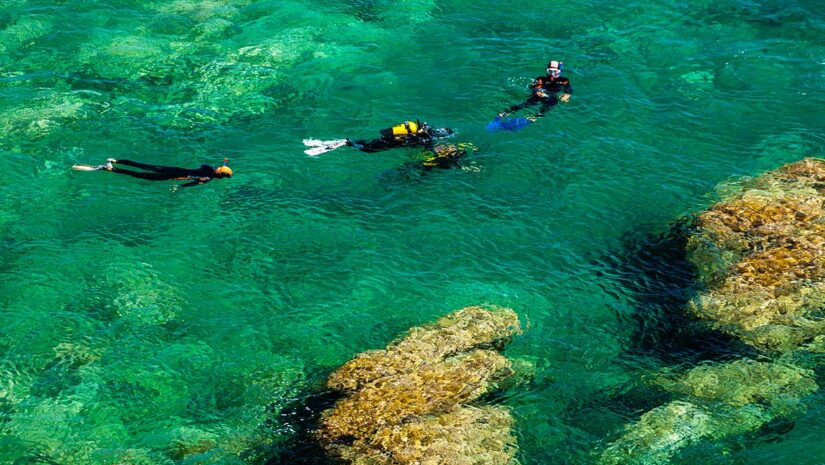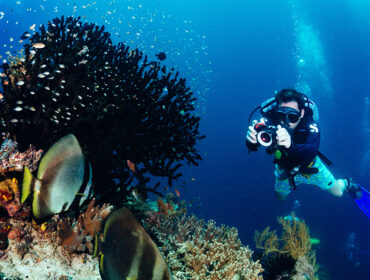If you’re new to scuba diving and were certified on a boat, it may come as a surprise to you that you don’t need a boat to scuba dive in many places across the globe. This type of diving is called shore diving, because your entry point is the shore. When shore diving, you simply walk into the water until you’re deep enough to submerge, at which point you put on your fins, let all the air out of your BCD, and begin establishing buoyancy for your dive.
While shore diving may sound like an easy venture, you still need to prepare every bit as well as if you were headed out on a boat dive.
What is shore diving?
Shore diving is a captivating underwater adventure that involves entering the ocean directly from the coastline, eschewing the need for boats. Unlike traditional boat diving, shore diving allows scuba enthusiasts to explore the underwater world right from the shore. It offers convenience, accessibility, and unique exploration opportunities. Divers navigate through shallow waters, discovering marine life, underwater formations, and hidden treasures just off the coast. It’s a more flexible and cost-effective way to dive, providing the freedom to embark on underwater journeys at one’s own pace. Shore diving opens up a new realm of underwater experiences, blending adventure and convenience in a single plunge.
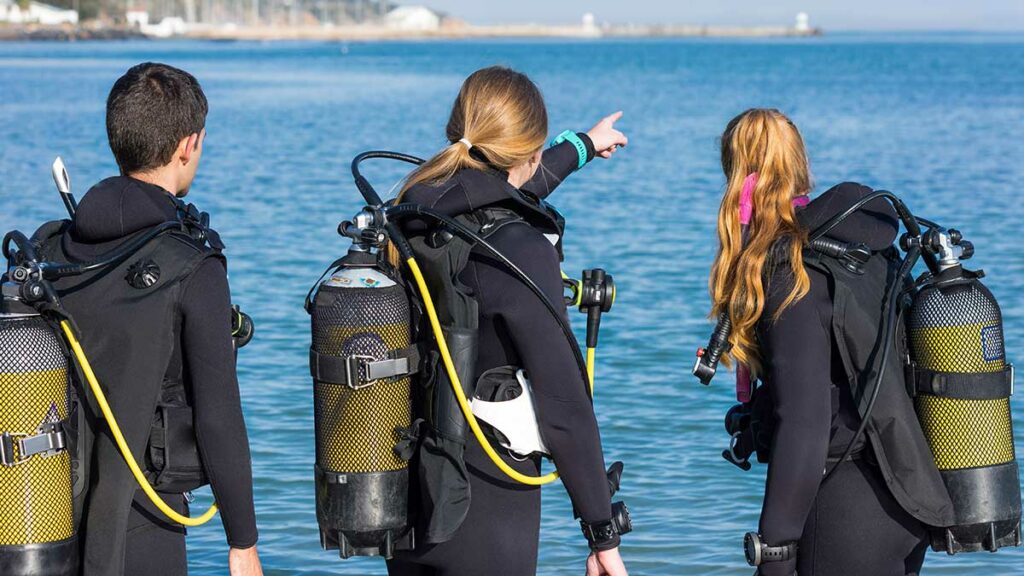
Advantages of Shore Diving
Accessibility and Convenience
Gone are the days of waiting for boat schedules and adhering to group timings. Shore diving offers the convenience of diving on your terms. With dive sites just a short stroll away, you have the flexibility to embark on underwater adventures at your preferred time, maximizing your time in the water.
Cost-Effectiveness
Let’s face it, boat diving can be pricey. Shore diving eliminates the need for boat rentals, reducing the financial burden on your diving budget. Furthermore, with fewer equipment requirements, you can streamline your gear, making it a more economical way to explore the depths.
Exploration Opportunities
Shore diving provides access to dive sites that are often overlooked by boat divers. These coastal treasures may hold hidden wonders waiting to be discovered, from vibrant marine life to intriguing underwater formations. Dive close to the shore and unlock a world of unique experiences.
Environmental Impact
By skipping the boat and directly accessing dive sites, shore divers contribute to reducing their carbon footprint. Additionally, the minimal disturbance caused to marine ecosystems when entering and exiting from shore sites helps protect delicate underwater environments.

How to Prepare for Shore Diving
Research and Planning
Before embarking on a shore diving adventure, thorough research is crucial. Choose dive sites that suit your skill level and interests. Understand the local conditions, including tide changes, currents, and potential hazards, to ensure a safe and enjoyable experience.
Gear Considerations
Appropriate gear is essential for a successful shore dive. Select wetsuits or drysuits based on the water temperature. Transporting and assembling equipment on land can be different from boat diving, so be prepared to manage your gear effectively.
Safety Measures
The buddy system is particularly important in shore diving. Establish clear communication protocols and an emergency action plan with your dive buddy. Carry a well-stocked first aid kit and familiarize yourself with the nearest medical facilities.
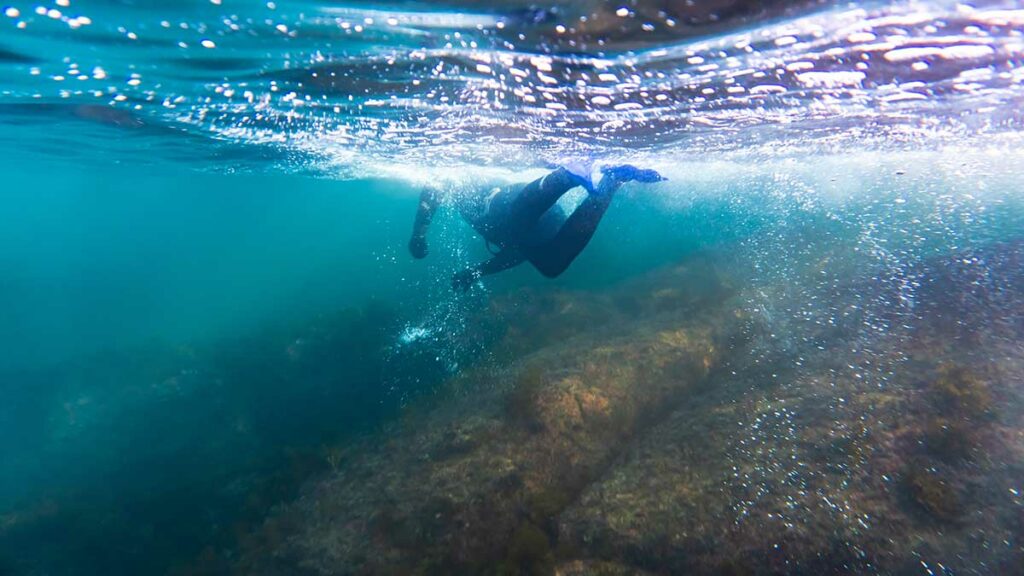
Tips for Shore Diving
Look Up the Underwater Topography of Your Site
Simply showing up, gearing up, and walking into a shore diving site without having any idea of the area you’re going to be diving is foolish and risky. It’s important to know all the available information about a shore dive site before you get in. This way, you can plan your dive around potential obstacles or hazards. The topographical features of a dive site will also aid you in natural navigation. Be sure to brush up on the dive site before you go.
Consult Tide Tables
Now that you know what your dive site actually looks like, it’s time to consult the tide table for your area. Our oceans are living, changing bodies, and the times at which tides are high or low will vary from day to day. You can download several apps for your phone that will bring this information instantly to your fingertips. Or you can check out NOAA’s Tides and Currents website to get tidal information for locations on the East, West, and Gulf Coasts of the US, and in the Pacific and Caribbean.
Go Slow
As you’re exerting yourself to make it to the dive site, play it cool and easy, don’t rush. Rushing an entry or trying hard to get to the site as fast as you can can make you tired and more susceptible to stress in the water. It also increases chance of injury. Take your time, breathe, assess the situation and make as smooth an entry as possible. Swim nice and slowly to the site without exerting yourself too much, inflating your BC once you’re in swim-able waters helps. Who knows, you could even find some great snorkeling sights worth checking out during the swim!
Establish and Orient to Your Entry/Exit Points
You can’t just get in the water and expect to surface in a reasonable, safe place. It’s all too easy to lose track of time and your course on a dive, particularly if there are interesting things to look at underwater. If it’s a drift dive, you run even more risk of becoming stranded or disoriented due to stronger currents moving you much faster through the water column. Before you even get in the water, one of the best tips for shore diving is to establish your entry and exit points (using the dive site map if possible) and stick to them.
Use Underwater Natural Navigation
If you’ve never taken a specialty course on compass navigation as part of your scuba certification process, not to worry. There are several underwater natural navigation techniques you can employ to ensure you’re staying on the right track. By using these techniques, you won’t be able to stray the opposite direction from shore or veer off in an entirely different direction than your planned course.
Deploy a Float or Dive Flag
Understanding the importance of deploying a dive flag or float is one of the strongest tips for shore diving we can give you. Giving the topside world a sign that someone is beneath the surface is just an obvious safety procedure. They range in price, but there’s no reason to spend more than is necessary for a simple, highly visible signal flag or float. It is necessary to own one, however, as it is just as much a piece of your life-sustaining equipment as your BCD or regulator when shore diving.
Practice Responsible Diving
Responsible diving practices are paramount in preserving marine ecosystems. Avoid touching or disturbing marine life, maintain proper buoyancy control to prevent damage to the seabed, and respect the delicate balance of underwater habitats.
Clean Up After Yourself
Leave no trace. Uphold the principle of minimizing your impact by properly disposing of trash and waste. Participate in local beach clean-up initiatives to actively contribute to the cleanliness and health of our oceans.
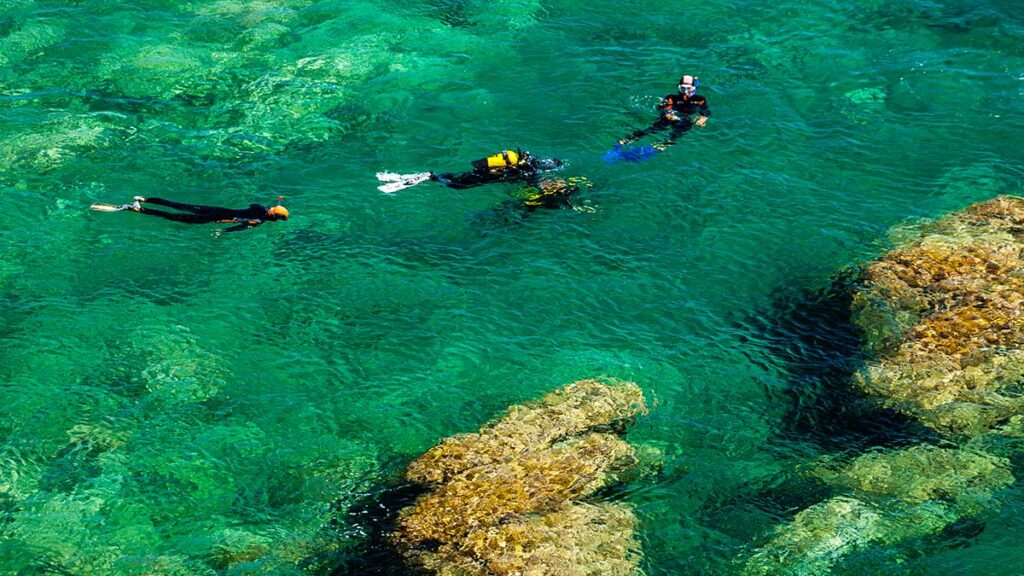
Best Shore Diving Destinations
For scuba diving enthusiasts, the allure of the underwater world knows no bounds. While boat dives offer a gateway to the deep, shore diving unveils a different facet of marine beauty, allowing divers to explore the depths from the coastline. From the turquoise waters of the Caribbean to the remote islands of the Pacific, here are some of the world’s top shore diving destinations and the reasons they captivate divers around the globe.
Bonaire, Caribbean
Dubbed “Diver’s Paradise,” Bonaire is a Caribbean gem renowned for its pristine reefs and crystal-clear waters. The island’s commitment to marine conservation is evident in its protected marine parks and abundant marine life. Shore divers have easy access to more than 80 marked dive sites, making Bonaire a haven for underwater explorers. The shallow reefs offer a cornucopia of marine species, while the “Bari Reef” boasts the distinction of being one of the most biodiverse sites in the Caribbean. With minimal currents and diverse marine life, Bonaire’s shore diving experience is a testament to nature’s splendor.
Maui, Hawaii
Hawaii’s allure as a tropical paradise extends beneath the waves. Maui, in particular, offers a captivating blend of volcanic formations, vibrant corals, and endemic marine species. The “Molokini Crater” is a popular shore diving site, boasting clear visibility and a thriving ecosystem. Divers can witness green sea turtles, manta rays, and a multitude of colorful fish species. Beyond marine encounters, Maui’s cultural richness and aloha spirit add an extra layer of enchantment to the diving experience.
Dahab, Egypt
For those seeking a unique blend of history and underwater beauty, Dahab is an unparalleled destination. The “Blue Hole,” a famed sinkhole that descends to great depths, offers an adrenaline-pumping shore diving experience. The vibrant coral formations, coupled with the allure of the unknown, make it a magnet for adventurous divers. Dahab’s “Canyon” dive site is equally captivating, featuring narrow passages and dramatic rock formations. The Red Sea’s warm waters and thriving marine life complete the allure of Dahab’s shore diving offerings.
Grand Cayman, Caribbean
Grand Cayman‘s “Eden Rock” and “Devil’s Grotto” are iconic shore diving sites, showcasing underwater mazes of tunnels, caves, and swim-throughs. The crystalline waters enhance the surreal beauty of these sites, allowing divers to swim among the intricate limestone formations and encounter diverse marine life. The “Stingray City Sandbar” offers the unique opportunity to interact with gentle southern stingrays, creating a remarkable and unforgettable diving memory.
Palau, Micronesia
Palau, an unspoiled jewel in Micronesia’s Pacific Ocean, boasts surreal landscapes above and below the waterline. The “Blue Corner” is a world-famous dive site known for its vibrant coral walls, strong currents, and thrilling encounters with sharks and other pelagic species. Palau’s unique mix of coral gardens, wartime wrecks, and vibrant marine life creates a diver’s paradise that’s best explored directly from the shore.
Conclusion
The most exciting part of shore diving is the element of exploration and adventure. Unlike in boat dives, where you are dropped off at the dive site itself and have a captain or dive guide who knows the site, tides, currents, and other considerations, with shore dives you’re mostly on your own (unless you opt for a dive master to accompany you).
Shore diving requires you to start planning more than just the dive at the site. It starts with getting to know the conditions and where exactly the site is, plotting a route to get to it, and finding the best entry points and techniques. By immersing yourself in this thrilling underwater pursuit, you’ll not only enrich your own experiences but also contribute to the preservation of our precious marine ecosystems.

